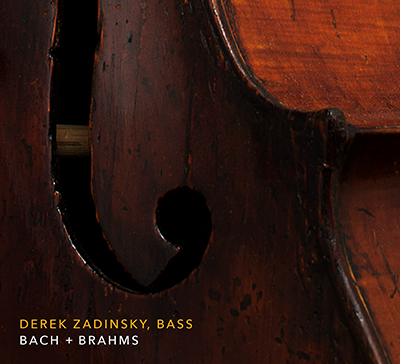by Mike Telin

The album, available by digital download from Oberlin Music, features technically flawless and emotionally gripping performances of Zadinsky’s own transcriptions of Bach’s Cello Suite No. 3 in C and Brahms’ Cello Sonata No. 1 in e.
When choosing the repertoire, Zadinsky, who is a member of The Cleveland Orchestra and a teacher at Oberlin Conservatory, quickly turned his attention to Bach, who often transcribed his own works for different instruments. The bassist also thought that the richness of Brahms’ music would translate to the voice of the bass.
The inclusion of the Bach, transposed to the key of G, also came with some words of warning from one of Zadinsky’s mentors, Edgar Meyer, who shied away from performing the Suite because of the section in the “Prelude” that requires successive open pedal notes to be closed by the left hand immediately after bowing. Zadinsky solves that problem by using a custom-built five-string bass that includes a high C string, which allows the passage to be played as it would be on a cello.
Zadinsky’s astute musicianship is evident from the beginning. The “Prélude” sings out with a full, rich tone and well-shaped lines. The “Allemande” is spritely, with every note purposefully leading to the next. The “Courante” conjures up images of a graceful dancing bear, while the double stops during the “Sarabande” take on a sweet sadness.
Well-chosen tempos in “Bourrées I & II” allow their harmonic structure to come through without getting blurry. Here Zadinsky shows his ability to nimbly traverse from the top to the bottom of the instrument. The second Bourrée takes on the character of an operatic aria, and the return to the first is joyful. In the concluding “Gigue” the bassist showcases a surprising agility. His double stops roar, in the best way, up to the instrument’s high register, making you forget exactly how big the instrument is. But isn’t that the way it should be?
Joined by the always impressive pianist Alicja Basinka, Zadinsky’s passion for the music of Brahms comes through loud and clear. The opening “Allegro non Troppo” is (choose your expletive) beautiful from beginning to end. The “Allegretto quasi Menuetto” is defined by clear articulations that are perfectly matched by Basinka, as are the shapely, nuanced lines. Playing in the instrument’s high tenor register, Zadinsky sings in full voice, bringing the work to an astonishing end.
The most impressive thing about Bach + Brahms is that after a minute in, you will forget that you are hearing a double bass and just relax and enjoy the music.
The album was recorded in Clonick Hall at Oberlin Conservatory. Production, mixing, and mastering are by Paul Eachus. Audio engineering and digital editing are by Paul Eachus and Andrew Tripp.
Distributed by Naxos of America, Bach + Brahms is available through digital music channels worldwide.
Published on ClevelandClassical.com December 12, 2019.
Click here for a printable copy of this article



